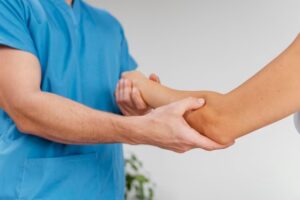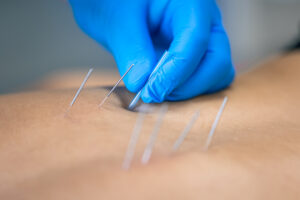
The elbow joint is a vital part of our upper extremity, permitting us to perform a large number of activities, from lifting objects to typing on a keyboard. Nonetheless, similar to any joint in the body, the elbow is defenseless to various types of pain and injury. One common and frequently incapacitating condition that influences the elbow is known as tennis elbow. In this article, we will investigate tennis elbow, its causes, symptoms, and various elbow pain treatment options accessible to give alleviation and work on the personal satisfaction of those impacted by this condition.

Understanding Tennis Elbow:
Tennis elbow, likewise medicinally alluded to as lateral epicondylitis, is a painful condition that fundamentally influences the tendons on the outer part of the elbow. In opposition to its name, tennis elbow isn’t restricted to tennis players; it can happen in anybody who performs repetitive arm motions and activities that strain the forearm muscles and tendons.
The essential driver of tennis elbow is abuse or repetitive weight on the forearm muscles and tendons, prompting little tears in the tendon tissue. This abuse frequently results from activities like tennis, golf, manual labor, painting, plumbing, and even unreasonable typing or computer mouse use. Tennis elbow can likewise be created because of poor technique, deficient equipment, or improper ergonomics.
Recognizing the Symptoms:
Tennis elbow appears through a scope of symptoms, and early recognition is critical for successful treatment. Common signs and symptoms of tennis elbow include:
Pain: The most observable symptom is a persistent, sharp pain on the outer part of the elbow. The pain may gradually deteriorate over the long run and become more serious during activities that include gripping, lifting, or twisting motions.
Weakness: Weakened hold strength is another common indicator of tennis elbow. People might find it trying to hold objects, shake hands, or turn doorknobs without distress.
Stiffness: Stiffness and restricted scope of motion in the elbow joint might be created as the condition advances.
Delicacy: Delicacy while contacting the outer part of the elbow is often present, particularly over the hard knock known as the lateral epicondyle.
Exploring Treatment Options:
Luckily, there are a few tennis elbow treatment options accessible, going from moderate ways to deal with additional invasive procedures. The decision of treatment relies upon the seriousness of the condition, the singular’s lifestyle, and their reaction to past treatments. Here are some common elbow pain treatment strategies:
1. Rest and Activity Modification
As a rule, giving the impacted arm satisfactory rest and changing activities that fuel the condition can give critical help. This might include briefly keeping away from the activities that set off the pain and taking on ergonomically sound techniques for daily tasks.
2. Physical Therapy
Physical therapy is frequently prescribed to strengthen the forearm muscles and further develop flexibility. Therapists might utilize techniques like manual therapy, exercises, and modalities like ultrasound or electrical stimulation to ease pain and promote healing.
3. Brace or Splint
Wearing a brace or splint intended to lessen stress on the forearm tendons can be helpful. These devices limit the development of the wrist and assist with circulating power all the more equitably through the arm.
4. Medications
Non-steroidal anti-inflammatory drugs (NSAIDs) like ibuprofen or naproxen can assist with decreasing pain and irritation related to tennis elbow. These medications are normally taken as coordinated by a healthcare provider.
5. Corticosteroid Injections
At times, a corticosteroid injection straightforwardly into the impacted region can give impermanent help from pain and irritation. In any case, rehashed utilization of corticosteroid injections is for the most part deterred because of expected secondary effects and hazard of tendon weakening.
6. Platelet-Rich Plasma (PRP) Therapy
PRP therapy includes infusing a concentrated arrangement of the patient’s platelets into the harmed tendon. This treatment intends to invigorate regular healing cycles and is viewed as a more safe option in contrast to surgery.
7. Shockwave Therapy
Extracorporeal shockwave therapy (ESWT) is a non-invasive procedure that utilizes high-energy shockwaves to animate healing in the impacted tendons. ESWT has shown a guarantee in giving alleviation to constant tennis elbow cases.
8. Surgical Intervention
In extreme instances of tennis elbow that doesn’t answer moderate tennis elbow treatment, surgical intervention might be important. The most common surgical procedure for tennis elbow is called lateral epicondyle discharge, in which the harmed tendon tissue is eliminated.
Prevention and Recovery:
Forestalling tennis elbow is much of the time more sensible than treating it once it is created. To lessen the risk of fostering this condition or to support recovery, think about the accompanying:
Proper Technique: Whether playing sports or performing daily tasks, utilizing the right techniques and ergonomics can essentially lessen the risk of abuse wounds.
Strength and Flexibility: Routinely captivating exercises that strengthen the forearm muscles and further develop flexibility can assist with forestalling tennis elbow.
Equipment: Guarantee that sports equipment and tools are appropriate to your body and activities. For instance, picking a tennis racket with a suitable hold size can have a tremendous effect.
Warm-up and Stretch: In every case warm up before participating in physical activities and consolidate stretching exercises to set up your muscles and tendons.
Gradual Progression: Keep away from unexpected expansions in the force or span of activities that pressure the forearm muscles.
Rest and Recovery: Pay attention to your body. On the off chance that you experience early indications of inconvenience or pain, have some time off and permit time for proper recovery.


